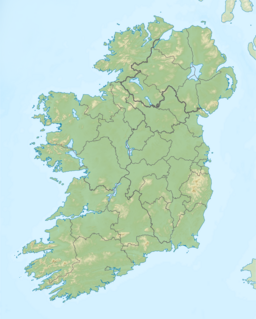Lough Arrow
| Lough Arrow | |
|---|---|
| Loch Arbhach(Irish) | |
 Toward the Bricklieve Mountains | |
| Location | County Sligo,County Roscommon |
| Coordinates | 54°3′12″N8°19′15″W/ 54.05333°N 8.32083°W |
| Lake type | mesotrophic |
| Primary inflows | Mainly spring-fed, also some streams |
| Primary outflows | Unshin River |
| Catchment area | 65.76 km2(25 sq mi) |
| Basincountries | Ireland |
| Max. length | 6 km (3.7 mi) |
| Max. width | 2 km (1.2 mi) |
| Surface area | 12.47 km2(4.81 sq mi) |
| Average depth | 9 m (30 ft) |
| Max. depth | 33 m (108 ft) |
| Surface elevation | 53 m (174 ft) |
| Islands | 4 |
| References | [1][2][3][4][5] |
Lough Arrow(Irish:Loch Arbhach)[6]is afreshwaterlake in the northwest of Ireland. This large, scenic lake covers an area of 12.47 square kilometres (4.8 sq mi) and lies mostly inCounty Sligowith a smaller part inCounty Roscommon.It is a popular trout fishing lake.
Geography
[edit]Lough Arrow lies mostly in south County Sligo about 24 kilometres (15 mi) southeast ofSligoand 6 km (4 mi) northwest ofBoyle.TheBricklieve Mountainsrise west of the lake.

Lough Arrow is about 6 km (3.7 mi) long from north to south and 2 km (1.2 mi) wide.[4]The lake has four islands: Annaghgowla, Inishmore, Inishbeg and Muck.[5]
Hydrology
[edit]Lough Arrow is amesotrophiclake. It is fed mainly by springs but also by a number of streams entering on the lake's western and southern sides.[1]The lake drains north into theUnshin River.[4][5]The mean lake depth is 9 m (30 ft) with a maximum depth of 33 m (108 ft).[4]
Natural history
[edit]Fish present in Lough Arrow includebrown trout,perch,roach,three-spined stickleback,pike,rudd,breamand the critically endangeredEuropean eel.[4]A number of duck species winter at the lake includingmallard,wigeon,teal,red-breasted merganser,tufted duck,pochardandgoldeneye.Other bird species found at the lake includegreat crested grebe,little grebe,cormorantandmute swan.[3]
Lough Arrow has been designated aSpecial Area of Conservationas a hard water lake habitat.[1]
History
[edit]A number of important historical sites are located in the area around Lough Arrow.Carrowkeel Megalithic Cemeteryis located in the Bricklieve Mountains above the lake's western side. It is one of the most extensive and best preserved complexes of theIrish passage tombtradition.[7]Moytura, located on the eastern side of the lake, featuresstanding stonesand is also the site of the mythologicalSecond Battle of Moytura.[8]
See also
[edit]References
[edit]- ^abc"Lough Arrow SAC"(PDF).National Parks and Wildlife Service (Ireland).Retrieved21 May2015.
- ^Free, Gary; Little, Ruth; Tierney, Deirdre; Donnelly, Karol & Caroni, Rossana (2006).A Reference Based Typology and Ecological Assessment System for Irish Lakes(PDF)(Report).Environmental Protection Agency (Ireland).p. 10.Retrieved12 October2022.
- ^ab"Lough Arrow".BirdWatch Ireland. Archived fromthe originalon 24 September 2015.Retrieved17 May2015.
- ^abcde"Water Framework Directive Fish Stock Survey of Lough Arrow"(PDF).Inland Fisheries Ireland.July 2012.Retrieved17 May2015.
- ^abcGoogle(17 May 2015)."Lough Arrow"(Map).Google Maps.Google.Retrieved17 May2015.
- ^"Loch Arbhach/Lough Arrow - logainm.ie".Gazetteer of Ireland.Government of Ireland - Department of Arts, Heritage and the Gaeltacht.Retrieved17 May2015.
- ^"The cairns at Carrowkeel".Carrowkeel.Retrieved17 May2015.
- ^"The Second Battle of Moytura".Carrowkeel.Retrieved17 May2015.
External links
[edit] Media related toLough Arrowat Wikimedia Commons
Media related toLough Arrowat Wikimedia Commons

